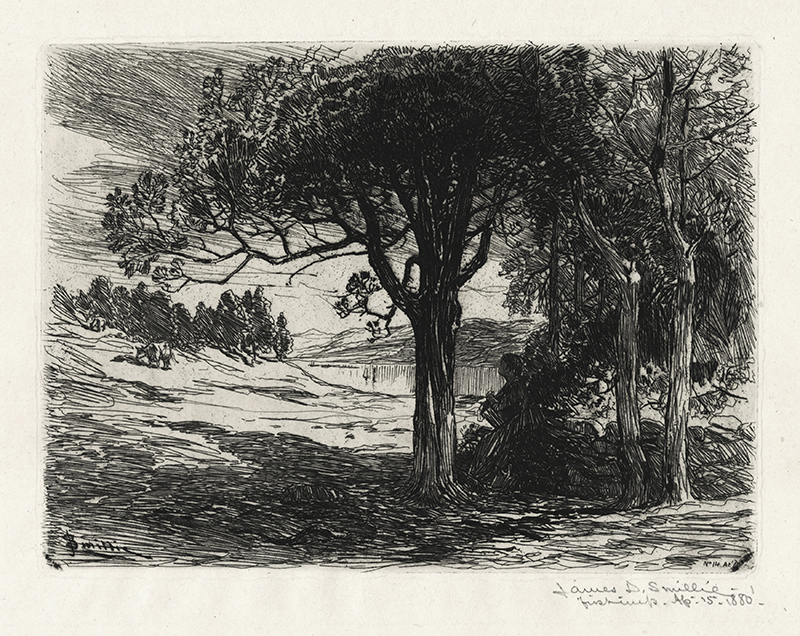
19th, 20th & 21st Century Fine Prints
707-546-7352 · fax 707-546-7924 · web: www.annexgalleries.com · email: artannex@aol.com
Cedar Meadows, Po'keepsie (Poughkeepsie) by James David Smillie

Cedar Meadows, Po'keepsie (Poughkeepsie)
James David Smillie
Cedar Meadows, Po'keepsie (Poughkeepsie)
James David Smillie
1833 - 1909 (biography)James D. Smillie noted that this etching was done on a zinc plate and was "destroyed in attempting to rebite". This is James D. Smillie's 16th etching. Smillie has annotated this impression as: "first imp - Ap. 15 - 1880". This is the impression illustrated in the Witthoft catalog raisonne and is the only known impression.
Poughkeepsie, New York, is sometimes called the "Queen City of the Hudson" and is located in the Hudson Valley between New York City and Albany. J.D. Smillie's parents, Catherine and artist James Smillie lived there and James D. would often spend time with them. His father had taught him etching and engraving and had a studio in which to work.
This bucolic landscape with shade trees, a pasture with a cow and a body of water in the background is what brought New York's movers and shakers to the area to build second homes as an escape from the city.
James David Smillie was born in New York City on January 16, 1833, the eldest son of Katharine van Valkenburg and James S. Smillie. His father, a noted engraver, had a major influence on nineteenth-century American engraving and etching and is probably best known for his banknote engraving with Rawden, Wright, and Hatch, and for his engravings after Thomas Cole's painting series, Voyage of Life.
James D. studied at the Poughkeepsie Collegiate School and later at the University of New York. It has also been noted that he studied at the National Academy of Design in New York. Young James learned the art of engraving from his father and when he was eight years old produced his first etching on copper, a visiting card plate. In January 1846, he tried his first attempt at composition with a watercolor of the fall of Satan after Milton's poem, Paradise Lost. He was employed as a bank note engraver before he and his father started their own engraving business; they specialized in banknotes but also produced the engravings for the 1857 Mexican Boundary Survey Report.
Smillie headed the watercolor committee for the Centennial International Exhibition of 1876. Held in Philadelphia, it was the first official World's Fair held in the United States and was a celebration of America's hundredth anniversary of independence. Smillie was elevated to full Academician in the National Academy of Design in 1876. As early as 1870, he attempted to interest fellow etchers in forming an etching club in New York but had no luck. In 1877, he co-founded the New York Etching Club and the first meeting was held in his studio. In 1881, he was elected as one of the "original fellows" of the London Society of Painter-Etchers.
